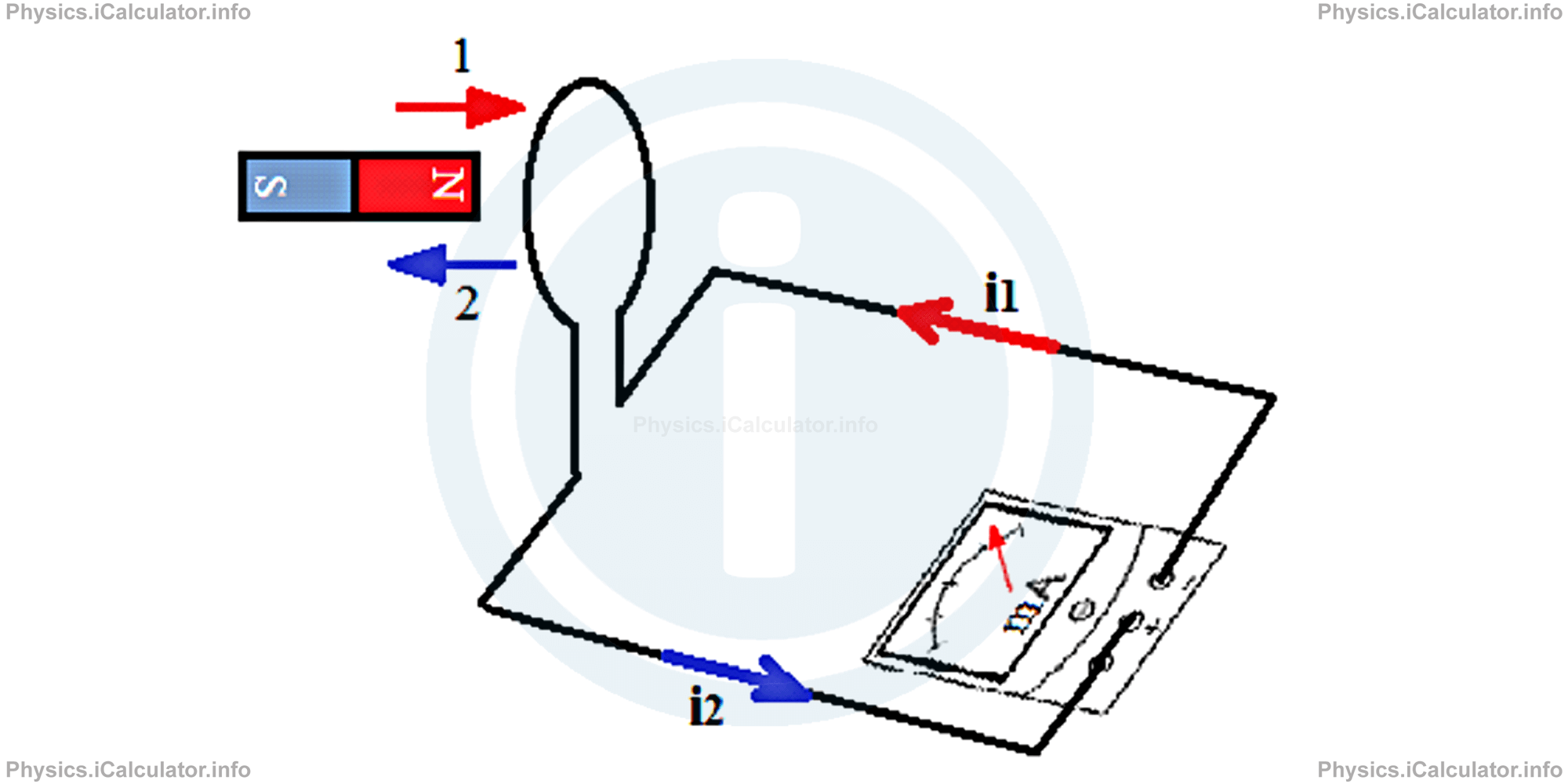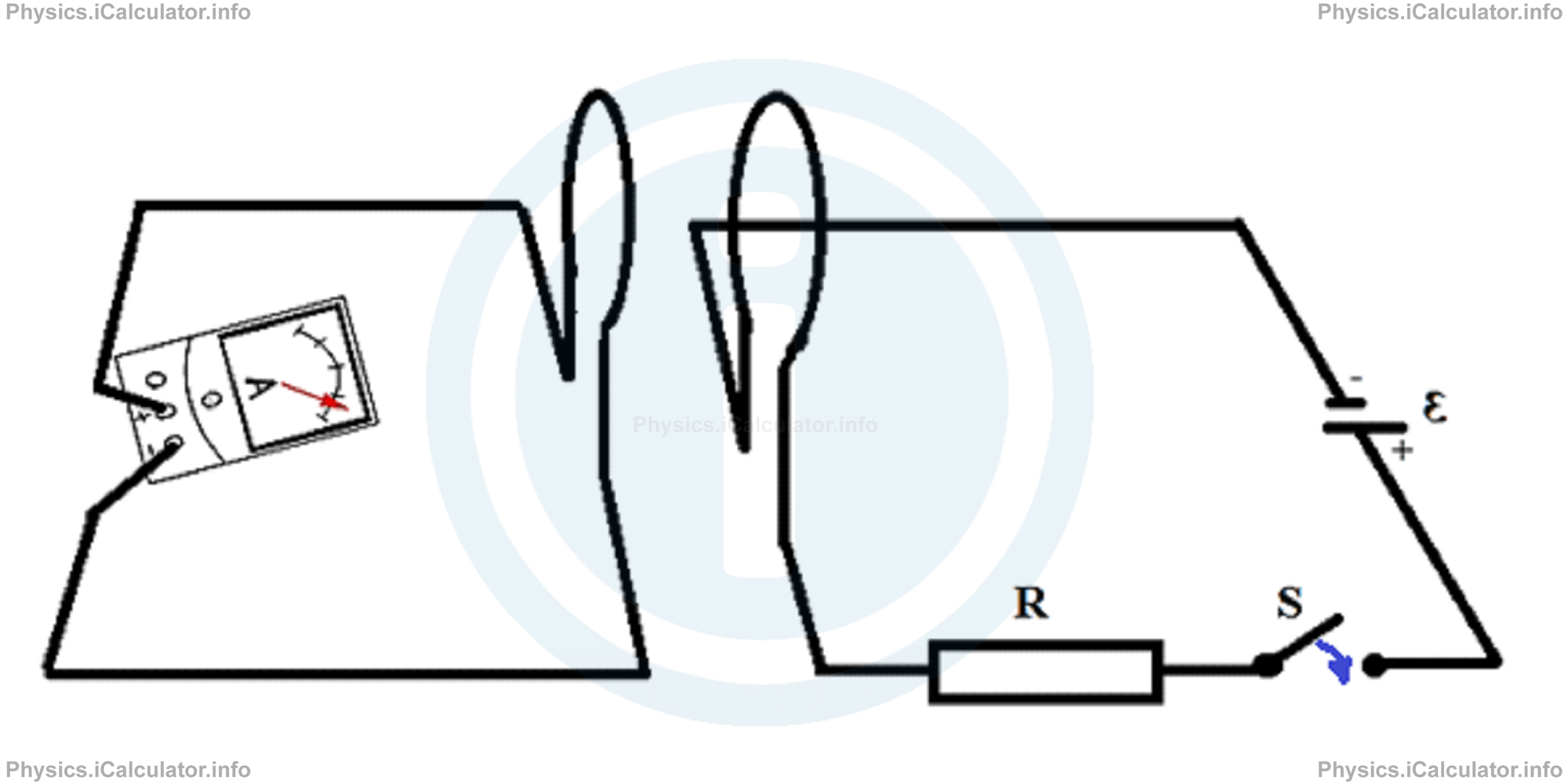Menu
Physics Lesson 16.7.1 - What did Faraday Observe during His Experiments?
Please provide a rating, it takes seconds and helps us to keep this resource free for all to use
Welcome to our Physics lesson on What did Faraday Observe during His Experiments?, this is the first lesson of our suite of physics lessons covering the topic of Faraday's Law of Induction, you can find links to the other lessons within this tutorial and access additional physics learning resources below this lesson.
What did Faraday Observe during His Experiments?
In tutorial 16.2 "Magnetic Field Produced by Electric Currents", we stated that Faraday did a famous experiment in which he discovered that a moving magnet generates electricity in a conducting wire if moved properly. We can observe better this property by making two experiments as follows.
First experiment. Let's consider a circular loop connected to a very sensitive ammeter as shown in the figure.

If we move the magnet towards the loop (direction 1), the ammeter arrow moves and indicates a non-zero current. The same thing occurs when the magnet moves in the opposite direction as well (direction 2). The only case when the ammeter shows zero current is when the magnet is changing direction. It is known than when an object is changing direction, stops for a while (for example, when we throw an object upwards, the velocity at the maximum position is zero).
This experiment shows that:
- Only a moving magnet is able to produce electric current in the loop; a stationary magnet does not produce any current.
- Faster the motion of magnet, greater the current produced in the loop.
- The direction of current changes when the direction of magnet's motion changes. For example, if we move the magnet towards the loop and the current produced is let's say clockwise, the direction of current in the loop will be anticlockwise if we move the same magnet away from the loop.
As we have stated in the tutorial 16.2, the current produced through this method is called induced current, as it is not obtained through direct contact but through induction. The work done to move the charges throughout the loop by means of this method is called induced emf (induced electromotive force).
Second experiment. For this experiment, we need two circular loops to be placed near each other, where one of them is connected to an electric circuit and the other to an ammeter as shown in the figure.

When the switch S turns on, the ammeter shows some current flowing through the left circular loop despite the loops are not touching each other. However, after a while the ammeter shows no current despite the switch is ON. When we turn the switch OFF, the current flows again through the left loop as the ammeter shows some current again.
This experiment is a demonstration that an induced current (and an induced emf) is produced in the loop connected to the ammeter (on the left side) due to the magnetic effect of current flowing in the loop on the right connected to the battery. Since this current is not produced through direct contact, it is an induced current. This current is not constant; it changes value and direction continuously every time we change the position of switch.
The two above experiments are demonstrations that a current is produced in the loop only if there is a change of something in proximity of loop. The reason why this change occurs, accompanied with the relevant theoretical explanation for which we will discuss in the next paragraph, was provided by Michael Faraday. That's why it is called the Faraday's Law of Induction.
You have reached the end of Physics lesson 16.7.1 What did Faraday Observe during His Experiments?. There are 4 lessons in this physics tutorial covering Faraday's Law of Induction, you can access all the lessons from this tutorial below.
More Faraday's Law of Induction Lessons and Learning Resources
Whats next?
Enjoy the "What did Faraday Observe during His Experiments?" physics lesson? People who liked the "Faraday's Law of Induction lesson found the following resources useful:
- Observations Feedback. Helps other - Leave a rating for this observations (see below)
- Magnetism Physics tutorial: Faraday's Law of Induction. Read the Faraday's Law of Induction physics tutorial and build your physics knowledge of Magnetism
- Magnetism Revision Notes: Faraday's Law of Induction. Print the notes so you can revise the key points covered in the physics tutorial for Faraday's Law of Induction
- Magnetism Practice Questions: Faraday's Law of Induction. Test and improve your knowledge of Faraday's Law of Induction with example questins and answers
- Check your calculations for Magnetism questions with our excellent Magnetism calculators which contain full equations and calculations clearly displayed line by line. See the Magnetism Calculators by iCalculator™ below.
- Continuing learning magnetism - read our next physics tutorial: Lentz Law
Help others Learning Physics just like you
Please provide a rating, it takes seconds and helps us to keep this resource free for all to use
We hope you found this Physics lesson "Faraday's Law of Induction" useful. If you did it would be great if you could spare the time to rate this physics lesson (simply click on the number of stars that match your assessment of this physics learning aide) and/or share on social media, this helps us identify popular tutorials and calculators and expand our free learning resources to support our users around the world have free access to expand their knowledge of physics and other disciplines.
Magnetism Calculators by iCalculator™
- Angular Frequency Of Oscillations In Rlc Circuit Calculator
- Calculating Magnetic Field Using The Amperes Law
- Capacitive Reactance Calculator
- Current In A Rl Circuit Calculator
- Displacement Current Calculator
- Electric Charge Stored In The Capacitor Of A Rlc Circuit In Damped Oscillations Calculator
- Electric Power In A Ac Circuit Calculator
- Energy Decay As A Function Of Time In Damped Oscillations Calculator
- Energy Density Of Magnetic Field Calculator
- Energy In A Lc Circuit Calculator
- Faradays Law Calculator
- Frequency Of Oscillations In A Lc Circuit Calculator
- Impedance Calculator
- Induced Emf As A Motional Emf Calculator
- Inductive Reactance Calculator
- Lorentz Force Calculator
- Magnetic Dipole Moment Calculator
- Magnetic Field At Centre Of A Current Carrying Loop Calculator
- Magnetic Field In Terms Of Electric Field Change Calculator
- Magnetic Field Inside A Long Stretched Current Carrying Wire Calculator
- Magnetic Field Inside A Solenoid Calculator
- Magnetic Field Inside A Toroid Calculator
- Magnetic Field Produced Around A Long Current Carrying Wire
- Magnetic Flux Calculator
- Magnetic Force Acting On A Moving Charge Inside A Uniform Magnetic Field Calculator
- Magnetic Force Between Two Parallel Current Carrying Wires Calculator
- Magnetic Potential Energy Stored In An Inductor Calculator
- Output Current In A Transformer Calculator
- Phase Constant In A Rlc Circuit Calculator
- Power Factor In A Rlc Circuit Calculator
- Power Induced On A Metal Bar Moving Inside A Magnetic Field Due To An Applied Force Calculator
- Radius Of Trajectory And Period Of A Charge Moving Inside A Uniform Magnetic Field Calculator
- Self Induced Emf Calculator
- Self Inductance Calculator
- Torque Produced By A Rectangular Coil Inside A Uniform Magnetic Field Calculator
- Work Done On A Magnetic Dipole Calculator